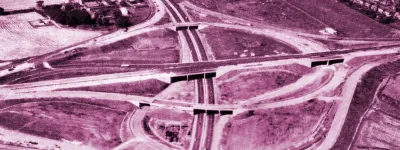Road signs use a recurring set of standard symbols to make them faster and easier to take in when travelling at speed. Recognising the symbols - and understanding what they mean - is key to understanding the signs.
Below are some of the commonest symbols used on signs, with variations and alternative designs, and their meanings.
Road users
Symbols indicating specific types of traffic or road user are mostly used where a sign refers to, or applies to, them. They might be used, for example, on a regulatory sign to indicate that a particular type of vehicle is prohibited, or that the road can only be used by them; or on parking signs to mark out bays intended for specific users.
On direction signs, the symbols will face towards the direction indicated.
There are symbols for four types of motorised traffic, indicating cars, lorries, buses and motorbikes. Cars can be shown from the side, head-on or from the rear. Buses can have the word "local" included inside the symbol, where the sign applies only to local scheduled bus services; lorries can have a weight included within the symbol.
Other road users indicated on signs are bicycles, pedestrians, horse riders and trams. There are multiple pedestrian symbols, including standing and walking, plus some less lifelike symbols for climbing and descending stairs.
There are also lesser-used symbols representing tractors, tanks, caravans, horse-drawn carriages and other vehicles, though many of these are specific to a single sign.
Arrows and directions
Many road signs involve directions, whether they are directing you to turn a particular way or pointing out a specific hazard. There are several types of arrow used on UK road signs, each of which has a different purpose.
The main type is the barbed arrow, which is used to point out directions on signs of all types. It can point any one of twelve ways - up, down, left, right, and diagonally at either 45 degrees or 30 degrees from vertical.
A flat downward-pointing arrow is used specifically to point out lanes on overhead signs, and relates the signs above to the road below. This arrow can never be used in any other orientation.
Chevrons, which are arrows without a stem, are used to indicate places where you need to turn immediately at the point where the sign is placed. They appear on direction signs sited at junctions, and on black-and-white signs that mark sharp bends.
Finally, the alignment or layout of the road ahead is indicated by arrows without barbs. On warning signs they may simply show a bend or a crossroads, but on map-type direction signs, these arrows can form complex shapes. Thicker lines indicate more important routes.
Motorways
Motorways are represented on signs by the motorway symbol, which represents a dual carriageway passing under a bridge. The symbol is used to indicate points where motorway regulations apply, so it is not used to point towards distant motorways and should only be found at entrance points to the motorway network.
The same symbol with a red diagonal strike through it indicates the end of motorway regulations.
Roadside facilities
Many of the other common symbols refer to things you can find or reach at the roadside.
Parking is indicated simply by the letter P on a blue background. Signs that show the colour blue crossed out are a restriction on parking or stopping.
Roadside services and amenities have many symbols, including toilets, fuel, food, picnic areas and public telephones.
Finally, other modes of transport are represented by the National Rail logo for railway stations, ships for vehicle ferry services (optionally containing cars, lorries or both), and an aeroplane for airports. On direction signs, ship and aeroplane symbols face the direction indicated, with the exception that the aeroplane should never point downwards below the horizontal: a direction arrow might point down to the side, but an aeroplane doing the same just looks like it's crashing.
